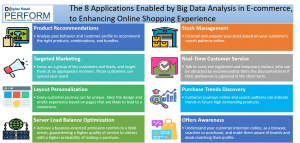Given the COVID-19 pandemic, retailers face an increasing migration of their customers to online and digital channels, such as E-commerce. Therefore, to enhance the experience of such consumers in those platforms is even more essential.
By enabling a smoothing and enjoyable online shopping experience, retailers will keep their customers’ engagement even after the pandemic is gone. With the analysis of customer behavior online and the rich data it provides, retailers will be able to target applications for enhancing their planning and the online journey of their customers.
PERFORM brings an infographic showing the 8 Applications enabled by Big Data analysis in E-commerce, to enhancing online shopping experience.
- Product Recommendation: Customers often get confused, given large amounts of goods online. Recommendations provide users with a fast and convenient way to discover and choose goods. It enables suggestions of products for the customer’s shopping basket, as bundles. In a situation where there are only a few seconds to attract customers’ attention, and other online stores are just a click away, online retailers must anticipate customer needs and identify potential or future buyers.
- Targeted Marketing: Predicted purchase proclivity enables online advertisers to adjust their advertising strategies for their targeted audience in different browsing modes. Thus, the online retailer’s ability to predict buying sessions increases the chances of achieving a competitive advantage by focusing on a group or groups of key customers . Retargeting has been a vital online advertising strategy to convert such window shoppers into purchasing customers. Merchants need to identify who can be converted to the regular loyal buyer and then target them to reduce promotion costs and increase the return on investment (ROI).
- Layout Personalization: Better interface design enriches user experience, such as order of results after a search query based on preference analysis of customer; optimization of disposition of products displayed , thus tailoring the onsite experience (e.g., a landing page). This application is enabled by understanding the specific interests of a customer in the short term, thus changing the website layout accordingly.
- Server Load balance Optimization: Optimize user experience online, and achieve a business-oriented admission control on a Web server, providing a higher quality of service to visitors with a higher probability of making a purchase under the server overload. That is important as there is an increase of customers going online.
- Stock Management: Forecasting demand for inventory management and optimization, which enables retailers with information on what specific products customers will intensively demand in the future.
- Real-time Customer Service: Users not registered and temporary visitors can be attracted by recommending them the discounted item if their preference for this item is determined by their short-term browsing information. For real-time settings, the tasks of Predicting Purchase Decision and Buying Sessions are crucial, as they are responsible for providing specific and short-term insights into customer’s activities on a website.
- Purchase Trends Discovery: It helps e-commerce companies understand their customer’s demands deeply, and capture their purchase tendencies for short and long term perspectives.
- Offers Awareness: Consumers can become aware of brands while they are online without any particular purchase activity. Customers might have different intentions when visiting E-commerce, such as searching, browsing, or buying. By understanding customer intent, retailers can tailor specific products or services connected to their intention of visiting the online store while still searching for products.
Sources:
- Cirqueira, Douglas, Markus Hofer, Dietmar Nedbal, Markus Helfert, and Marija Bezbradica. “Customer Purchase Behavior Prediction in E-commerce: A Conceptual Framework and Research Agenda.” In International Workshop on New Frontiers in Mining Complex Patterns, pp. 119-136. Springer, Cham, 2019.
- Jia, R., Li, R., Yu, M., Wang, S.: E-commerce purchase prediction approach by user behavior data. In: 2017 International Conference on Computer, Information and Telecommunication Systems (CITS), IEEE (2017) 1–5
- Tang, L., Wang, A., Xu, Z., Li, J.: Online-purchasing behavior forecasting with a firefly algorithm-based svm model considering shopping cart use. Eurasia Journal of Mathematics, Science and Technology Education 13(12) (2017) 7967–7983
- Zheng, B., Liu, B.: A scalable purchase intention prediction system using extreme gradient boosting machines with browsing content entropy. In: 2018 IEEE International Conference on Consumer Electronics (ICCE), IEEE (2018) 1–4
- Suchacka, G., Chodak, G.: Using association rules to assess purchase probability in online stores. Information Systems and e-Business Management 15(3) (2017) 751–780
- Liu, G., Nguyen, T.T., Zhao, G., Zha, W., Yang, J., Cao, J., Wu, M., Zhao, P., Chen, W.: Repeat buyer prediction for e-commerce. In: Proceedings of the 22nd ACM SIGKDD International Conference on Knowledge Discovery and Data Mining, ACM (2016) 155–164
- Zeng, M., Cao, H., Chen, M., Li, Y.: User behaviour modeling, recommendations, and purchase prediction during shopping festivals. Electronic Markets (2018) 1–12
- Chen, C., Xiao, J., Hou, C., Yuan, X.: Improving purchase behavior prediction with most popular items. IEICE TRANSACTIONS on Information and Systems 100(2) (2017) 367–370
- Chen, C., HOU, C.y., XIAO, J.k., YUAN, X.j.: Predicting purchase behavior of e-commerce customer, one-stage or two-stage? DEStech Transactions on Computer Science and Engineering (aics) (2016)
- Suchacka, G., Stemplewski, S.: Application of neural network to predict purchases in online store. In: Information Systems Architecture and Technology: Proceedings of 37th International Conference on Information Systems Architecture and Technology–ISAT 2016–Part IV, Springer (2017) 221–231
- Suchacka, G., Skolimowska-Kulig, M., Potempa, A.: Classification of e-customer sessions based on support vector machine. ECMS 15 (2015) 594–600
- Iwanaga, J., Nishimura, N., Sukegawa, N., Takano, Y.: Estimating product-choice probabilities from recency and frequency of page views. Knowl.-Based Syst. 99 (2016) 157–167
- Nishimura, N., Sukegawa, N., Takano, Y., Iwanaga, J.: A latent-class model for estimating product-choice probabilities from clickstream data. CoRR abs/1612.06589 (2016)
